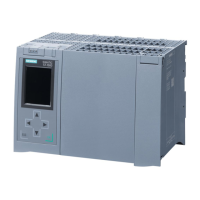System overview
5.1 What is the S7-1500R/H redundant system?
S7-1500R/H redundant system
80 System Manual, 01/2024, A5E41814787-AF
5.1.4 Scalability
Introduction
Redundant systems are more cost-intensive to use than non-redundant systems:
• There are two CPUs.
• The physical connections (PROFINET ring and redundancy connections) can be required
over large distances.
The S7-1500R/H redundant system is scalable. This means that the S7-1500R and S7-1500H
systems have the same functional scope, but differ in terms of:
• Performance
• Hardware
• Configuration versions
• Range
• Configuration limits
• Costs
MRP interconnection allows the redundant coupling of two or more rings with MRP in
PROFINET networks. With MRP interconnection, you are not limited to the maximum
number
of devices in a ring when setting up redundant network topologies. You can find more
information in the Redundancy (Page 97) section.
S7-1500R
You connect the CPUs to the Industrial Ethernet over X2 PROFINET interfaces of CPUs S7-
1515R-2 PN or using an additional switch.
S7-1500R supports the following number of PROFINET devices (switches, S7-1500R CPUs, S7-
1500 CPUs (V2.5 or later), HMI devices, and IO devices such as ET 200MP and ET 200SP):
max. 50 (recommended: max. 16) in the PROFINET ring
S7-1500R supports the following number of IO devices on the R CPUs: max. 64 in PROFINET
ring and decoupled by switches (additional line topology)
-1500R: Operate a maximum of 16 PROFINET devices (including
-CPUs) in the PROFINET ring.
The number of devices in the PROFINET ring affects the availability of the S7
-1500R system.
therefore operate no more than 16 PROFINET devices (including R-CPUs) in the
PROFINET ring. Operating significantly more devices in the PROFINET ring will reduce the
availability of the IO devices and the R
-CPUs.
The technical specifications in the documentation are based on the recommended maximum
of 16 PROFINET devices in the ring in S7-1500R.

